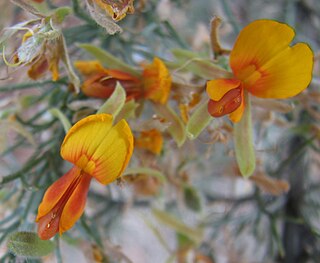
Jacksonia furcellata, commonly known as grey stinkwood, is a species of flowering plant in the family Fabaceae and is endemic to the south-west of Western Australia. It is a prostrate to low-lying, or weeping erect shrub with greyish-green branches, sharply-pointed side branches, its leaves reduced to scales leaves, yellowish-orange flowers, and woody, hairy pods.

Jacksonia sericea, commonly known as waldjumi, is a species of flowering plant in the family Fabaceae and is endemic to the south-west of Western Australia. It is a spreading to prostrate shrub with greyish-green branches, straight, sharply-pointed side branches, leaves reduced to scales, orange flowers with red markings, and woody, densely hairy pods.

Jacksonia sternbergiana, commonly known as stinkwood, is a species of flowering plant in the family Fabaceae and is endemic to the south-west of Western Australia. The Noongar peoples know the plant as kabbur, koorpa or mondurn. It is an erect or weeping shrub or tree with dull green branches, straight, sharply-pointed side branches, its leaves reduced to scales, yellowish-orange flowers, and woody, hairy pods.
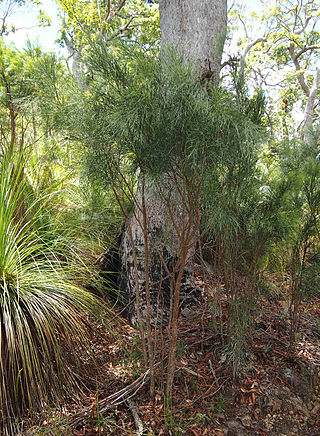
Jacksonia scoparia, commonly known as dogwood or winged broom-pea, is a species of flowering plant in the family Fabaceae and is endemic to Queensland and eastern New South Wales. It is a shrub or small tree with angled or winged branchlets, leaves usually reduced to scales, cream-coloured to orange-yellow flowers and oblong, hairy pods.

Eutaxia parvifolia is a species of flowering plant in the family Fabaceae and is endemic to southwestern Western Australia. It is a shrub with reddish brown stems, elliptic to egg-shaped leaves with the narrower end towards the base, and mostly yellow, red or orange flowers, with yellow red or orange markings.

Jacksonia lehmannii is a is a species of flowering plant in the family Fabaceae and is endemic to the south-west of Western Australia. It is an erect to prostrate or spreading, spindly shrub with greyish-green branches, sharply-pointed side branches, its leaves reduced to scales leaves, yellowish-orange flowers with orange-red markings, and woody, hairy pods.
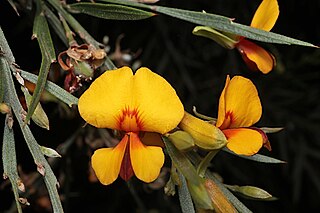
Jacksonia horrida is a species of flowering plant in the family Fabaceae and is endemic to the south-west of Western Australia. It is an erect or spreading to prostrate, bushy shrub with greyish-green branches ending in short, flattened, sharply-pointed side branches, the leaves reduced to scales and the flowers scattered and yellow-orange with red markings.

Prostanthera canaliculata is a species of flowering plant in the family Lamiaceae and is endemic to the south-west of Western Australia. It is a small, erect shrub with hairy branchlets, narrow egg-shaped to narrow elliptical leaves and pale blue or pale violet to white flowers with no markings.
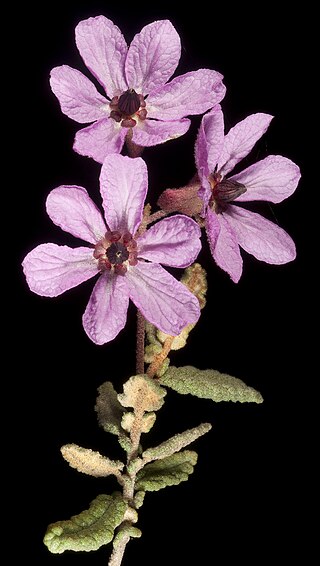
Lysiosepalum rugosum, also known as the wrinkled-leaf lysiosepalum, is a species of flowering plant in the mallow family and is endemic to the south-west of Western Australia. It is shrub with its young branches covered with woolly, star-shaped hairs, and has narrowly egg-shaped leaves and blue, purple of pink flowers usually in groups of 4 to 6.
Lasiopetalum angustifolium, commonly known as narrow leaved lasiopetalum, is a species of flowering plant in the family Malvaceae and is endemic to coastal areas of south-western Western Australia. It is a low spreading or dense, compact shrub with narrowly egg-shaped to narrowly elliptic leaves and compact groups of pink to purplish flowers.

Lasiopetalum drummondii is a species of flowering plant in the family Malvaceae and is endemic to the south-west of Western Australia. It is an erect, slender shrub with many densely hairy stems, egg-shaped or oblong leaves and white, pink and red flowers.

Lasiopetalum ogilvieanum is a species of flowering plant in the family Malvaceae and is endemic to the south-west of Western Australia. It is an open, spindly or rounded shrub with rusty-hairy young stems, narrowly egg-shaped to narrowly elliptic leaves and white or pink and dark red flowers.

Lasiopetalum oppositifolium is a species of flowering plant in the family Malvaceae and is endemic to the south-west of Western Australia. It is an open, erect shrub with rusty-hairy young stems, linear, narrowly elliptic or narrowly egg-shaped leaves and white, pink and dark red flowers.
Thomasia × formosa is a species of flowering plant in the family Malvaceae and is endemic to a restricted area of the south-west of Western Australia. It is an erect, compact shrub with densely hairy branchlets, hairy, coarsely serrated, egg-shaped to elliptic or oblong leaves, and racemes of pink or purple flowers arranged in leaf axils.
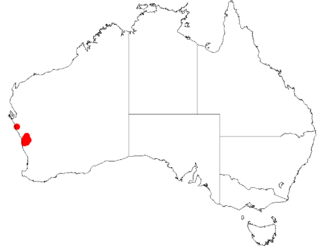
Pityrodia viscida is a flowering plant in the mint family Lamiaceae and is endemic to the south-west of Western Australia. It is an erect shrub with sticky hairy stems, egg-shaped to narrowly elliptic leaves and white bell-like flowers.

Jacksonia acicularis is a species of flowering plant in the family Fabaceae and is endemic to the west of Western Australia. It is an erect, spindly shrub with very sharply-pointed short side branches, leaves reduced to scales, orange flowers with red markings, and densely hairy pods.

Jacksonia aculeata is a species of flowering plant in the family Fabaceae and is endemic to the northern Australia. It is a spreading shrub with sharply-pointed, hairy, short side branches, leaves reduced to scales, lemon-yellow flowers, and woody, hairy pods.

Jacksonia alata is a species of flowering plant in the family Fabaceae and is endemic to the south-west of Western Australia. It is a tufted, semi-prostrate to erect shrub with flattened branches, sharply-pointed side branches or phylloclades, leaves reduced to narrowly lance-shaped scales, yellow-orange flowers with a red "eye", and woody, densely hairy pods.

Jacksonia angulata is a species of flowering plant in the family Fabaceae and is endemic to the south-west of Western Australia. It is a tufted, spreading to prostrate shrub often with zig-zagged branches, sharply-pointed side branches or phylloclades, leaves reduced to broadly egg-shaped scales, yellow-orange to orange flowers with a red "eye", and woody, densely hairy pods.

Jacksonia arenicola is a species of flowering plant in the family Fabaceae and is endemic to the south-west of Western Australia. It is an erect, broom-like shrub with densely hairy, sharply-pointed phylloclades, yellow-orange flowers with red markings, and woody pods that are hairy at first, later glabrous.




















